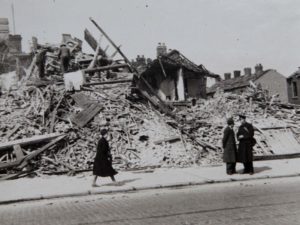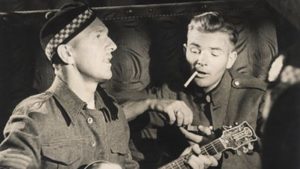Wartime Cinema-Going and the Belfast Blitz: Part 3
Sam Manning completes his exploration of the cinema in wartime Belfast by looking at how the city and it's cinemas recovered from the bombing raids.
Part 3: The City Recovers
More than 100,000 people fled Belfast after the raid, seeking refuge in the surrounding towns and villages of Northern Ireland. This led to a short-term drop in attendance for many Belfast cinemas and perhaps also accounts for the crowds who flocked to the Garden cinema in Warrenpoint.

By mid-May crowds were already returning to Belfast cinemas. The Northern Whig reported that cinema managers ‘found that the late “houses” were not so crowded as usual, but what they lost on swings they gained on roundabouts. Day and early evening performances were more popular than ever, the effect of the “Blitz” being to achieve a voluntary curfew, clearing the streets before “black-out” time’. One cinema manager commented that after the Blitz cinemas were needed more than ever: ‘People are too strung-up to rest, and a good film or play lifts them out of themselves. Naturally they don’t want ‘heavy’ stuff, but it’s marvellous the effect a comfortable seat and a cheerful piece of entertainment can have. It seems to help people carry on’.
They were also on hand to help the relief effort with fundraisers and special screenings. The Imperial, for instance, donated the proceeds of a screening of Andy Hardy Meets Debutante to the Lord Mayor of Belfast’s Air Raid Relief Fund.

By October 1941 several cinemas damaged during the raids, including the Park, the Savoy and the Capitol, had all reopened. And by the end of the year, some cinemas were doing better than ever. The Imperial reported that its showing of Men of Boys Town ‘broke every record which had been set up in the long history of the house as far as attendance is concerned’. Cinema foyers also offered space to reflect upon the damage caused to the city. In 1942, for instance, the National Fire Service presented a free exhibition of Blitz photographs in the foyer of the Classic to promote its recruitment week.
After the Blitz, exhibitors faced new challenges and the arrival of US troops in Northern Ireland increased the pressure and demand for the opening of Sunday cinemas in Belfast. The Kelvin and the Imperial eventually opened on Sundays for members of the armed forces from 1942 onwards. And these troops noted an increased desire for escapism after what the citizens of Belfast had suffered through.
By 1944, one American serviceman said that ‘all the theaters are jammed in the evening. The queues go around the corners, and one doesn’t see where they end because of the blackout’. It is also no surprise that the contested politics of Northern Ireland made their way from the streets and into the auditorium during the war. Many cinemas in nationalist areas refused to exhibit British propaganda films and one report observed that concerned managers ‘go about their showmanship armed with revolvers’. In 1943, six men armed with revolvers entered the Clonard cinema on the Falls Road, demanding an Easter Rising anniversary meeting after the evening’s performance.

After the end of the war, the Popular was rebuilt and opened its doors as a ‘modern 1,500 seater’. At the (re)opening ceremony in November 1946, the Lord Mayor of Belfast made it clear that ‘the materials used in the reconstruction were those which were not in the least needed for the city housing programme’. Declining audiences and rising costs meant that, like many other cinemas, it finally shut its doors in the early sixties.
Those who lived in areas heavily damaged during 1941 later recalled the role that lost cinemas played in the local community. Writing in the late 1980s, James Doherty stated that ‘although [the Midland] was destroyed in the Blitz it lives on in the imagination of the younger generation who only know of the pre-war years and the terrible depression, from stories told by their parents or grandparents’.
In a poem reflecting on his youth in and around York Street, John Campbell lamented the loss of both Joe’s and the Queen’s, stating that they had ‘vanished like a dream’. Though there were other alternatives in the area, such as the Duncairn, the Troxy and the Lyceum, these cinemas were evidently still sorely missed. John later told the author that a hoarding advertising Errol Flynn as Robin Hood remained next to the former site of the Midland years after its destruction, acting as a visual reminder of the cinema that once stood there.
Perhaps these cinemas destroyed in the war do not share the same public profile as grander venues such as the Curzon, the Classic or the Ritz, but looking back on them 80 years later shows the ways in which Belfast cinemas were shaped by the Second World War and the bombs that fell on the city in the Spring of 1941.
Dr Sam Manning teaches at Queen’s University Belfast and is a postdoctoral researcher on the AHRC European Cinema Audiences project at Oxford Brookes University. He has recently published articles on the history of cinemas in Northern Ireland in Cultural and Social History and Media History.
Further Reading
Brian Barton, Northern Ireland in the Second World War (1995)
Brian Barton, The Blitz: Belfast in the War Years (1989)
James Doherty, Standing Room Only: Memories of Belfast Cinemas (1997)
Stephen Douds, The Belfast Blitz: The People’s Story (2011)
Richard Farmer, Cinemas and Cinemagoing in Wartime Britain, 1939–45: The Utility Dream Palace (2016)
Philip Ollerenshaw, Northern Ireland in the Second World War (2013)
Michael Open, Fading Lights, Silver Screens: A History of Belfast Cinemas (1985)
Marcus Patton, Central Belfast: An Historical Gazetteer (2nd edition, 2015)
Kevin Rockett with Emer Rockett, Film Exhibition and Distribution in Ireland, 1909–2010 (2011)
